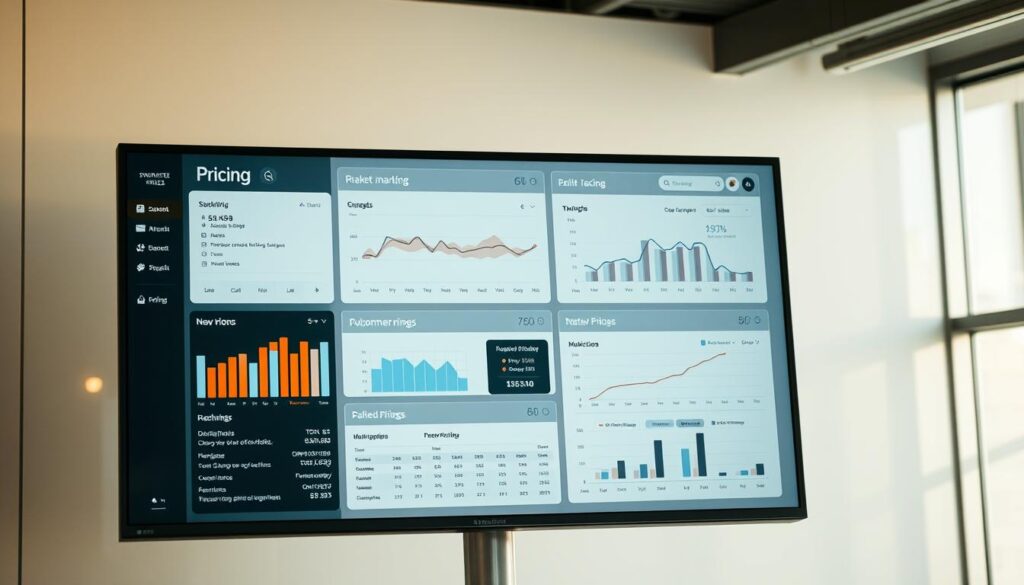In today’s fast-moving markets, using GTM automation for smart pricing strategies is crucial for companies wanting to boost their income. With top-tier pricing optimization software, firms can fine-tune their pricing plans. They look at detailed market studies and what customers want. This article explores the key parts of strategic pricing automation. It highlights how important GTM automation is for steady growth. As markets change and what people like shifts, using these automated tools helps brands set prices smartly. They base their choices on solid data and adjust quickly to appeal to their customers.
Key Takeaways
- Understanding the importance of GTM automation in pricing strategies.
- Leveraging pricing optimization software for effective decision-making.
- Recognizing the impact of data-driven insights on revenue optimization.
- Essential components that make up a successful GTM automation strategy.
- The necessity of adapting to evolving market conditions and consumer preferences.
Understanding GTM Automation in Pricing Strategy
GTM automation is key in today’s pricing strategies. It helps businesses set the right prices using technology. With it, businesses can look at market data and customer details to make better choices. This way, they can reach their business goals.
Definition of GTM Automation
GTM automation means using special tools to make pricing easier. It helps figure out the best prices by looking at the market and what customers do. The goal is to help companies set prices that bring in more money but keep them competitive.
Key Components of GTM Automation
For GTM automation to work well, several things are important:
- Market Analysis: Knowing about the competition and what customers want.
- Sales Strategy: Making pricing match the sales goals.
- Pricing Models: Creating ways to change prices easily.
- Customer Support: Having good support for any pricing questions.
Benefits of Implementing GTM Automation
Using GTM automation for pricing has many benefits:
- Enhanced Accuracy: Makes fewer mistakes in pricing.
- Improved Resource Allocation: Makes processes smoother and saves resources.
- Risk Mitigation: Helps plan for market changes better.
- Focused Messaging: Makes marketing messages that speak to customers.
- Accelerated Revenue Growth: Adjusts prices quickly to grab market chances.
By adding GTM automation, companies can better manage pricing challenges. It opens up new ways to succeed and helps them stay leading in the market.
The Role of Data Analytics in Pricing Decisions
Data analytics plays a big part in setting prices. It lets businesses make pricing choices based on strong evidence and the current market. Companies that use data to make decisions can adjust their prices to meet what customers want. They also stay competitive.
Importance of Data-Driven Insights
Using data helps companies set better prices. They can spot trends, find opportunities, and understand their customers better. By looking at lots of data, they can figure out what their customers like and set prices in a smarter way. This helps companies sell more and earn more money.
Tools for Analyzing Pricing Data
There are many tools to look at pricing data. Pricing optimization software uses formulas to find the best price. It looks at past data and what’s happening in the market. Many tools can also connect with CRM systems. This helps companies look at how they interact with customers and where they stand against competitors.
Case Studies: Successful Data Utilization
Some companies have done a great job using data to decide on prices. Peloton, for example, changed its prices based on data and improved its place in the market. This shows how using data well can help companies make smart pricing choices. These choices can really help a company do better financially.

Strategies for Effective Pricing with GTM Automation
To set effective prices, understanding different models and analyses is key. Using a dynamic pricing strategy helps businesses adjust prices to meet market demand. This means prices change based on how many people want to buy. By checking competitor prices, businesses can see how their products compare and make changes if needed. Considering prices for different areas ensures prices fit the local market. GTM automation combines all these parts, making pricing more accurate and flexible.
Dynamic Pricing Models
Dynamic pricing lets businesses adjust prices based on demand, how consumers behave, and what competitors charge. This way, they can earn more while staying ahead of the competition. Factors that impact dynamic pricing include:
- Market demand shifts
- Time-sensitive promotions
- Consumer purchasing trends
Competitive Pricing Analysis
Looking closely at competitors’ prices helps businesses find their spot in the market. It shows where there’s room to offer something different or better. Key parts of this analysis are:
- Identifying competitor pricing structures
- Analyzing promotional strategies
- Monitoring market share movements
Geographic Pricing Considerations
Geographic pricing adjusts for what people in different areas prefer and can afford. It makes sure prices match what’s going on in the local market. It’s important to look at:
- Regional economic factors
- Local consumer behavior
- Cost variations across different locations
| Pricing Strategy | Description | Benefits |
|---|---|---|
| Dynamic Pricing | Adjusts prices in real-time based on demand and competition | Maximizes revenue, enhances competitiveness |
| Competitive Pricing Analysis | Compares pricing strategies against competitors | Identifies strategic positioning, encourages innovation |
| Geographic Pricing | Sets prices based on regional economic conditions | Increases market relevance, boosts sales |
Integrating GTM Automation with Existing Systems
Many businesses fail to see the importance of integrating GTM automation with existing systems. This step needs effective team work and ongoing support. By using API integrations, pricing software works well with current systems. This makes things more efficient and boosts GTM pricing strategy results.
API Integrations and Compatibility
API integrations let different platforms talk to each other well. They enable instant updates and sharing of data. This makes the pricing strategy more complete. Companies should check their systems to pick APIs that fit their pricing needs. This will make their pricing more flexible and responsive, improving their market stance.
Training and Change Management
New automation tools work best when team members are well-trained. Proper training on these tools makes users more confident and skilled. With the right skills, employees can fully use new pricing strategies. Pairing this with change management addresses resistance, making it easier to switch to automation.
Performance Monitoring and Optimization
Watching how well GTM automation works is key. Setting clear goals lets companies judge their pricing strategies. By always looking for ways to get better, companies stay adaptable. It’s crucial to keep optimizing for success, making sure the pricing software keeps up with market changes.
| Aspect | Importance | Best Practices |
|---|---|---|
| API Integrations | Ensures data flow between systems | Choose compatible solutions |
| Training | Enhances user effectiveness | Regular skill updates |
| Performance Monitoring | Tracks pricing strategy success | Set clear metrics |
Challenges in Implementing GTM Automation
Starting GTM automation comes with many hurdles for businesses. The process includes various challenges that can slow things down. It’s crucial to understand and overcome these hurdles to succeed.
Common Obstacles Faced by Businesses
One big challenge is the resistance to change. Workers often worry about how new tech might affect their jobs. Problems with tech infrastructure can also make automation tools less effective. This can lead to frustrations. Moreover, issues with integrating data can disrupt smooth automation.
Strategies to Mitigate Risks
To make the transition easier, applying certain strategies is key. Trial runs help identify issues before doing things on a larger scale. Involving stakeholders from the start encourages teamwork and problem-solving. And, ensuring teams have the support and training they need is crucial for adapting to new processes.
The Role of Leadership in Driving Change
Strong leadership is critical in navigating GTM automation challenges. Leaders should support innovation and listen to feedback from the team. This can lead to improvements that fit the company’s goals better. When leaders are fully behind automation, it helps everyone adapt and boosts the success of the technology.
| Challenges | Impact | Risk Mitigation Strategies |
|---|---|---|
| Resistance to Change | Decreased productivity, employee disengagement | Stakeholder engagement, training programs |
| Inadequate Tech Infrastructure | Implementation delays, compatibility issues | Assessment of current systems, investment in upgrades |
| Data Integration Challenges | Inconsistent data flow, analysis complications | Data standardization, dedicated IT support |
Future Trends in GTM Automation for Pricing
The GTM automation landscape for pricing is changing fast. It’s shaped by new tech and creative approaches. Businesses need to watch these trends closely to stay ahead. They should look at high-tech tools like AI and machine learning. These tools are key for better pricing strategies.
Emerging Technologies Influencing Pricing
New automation technologies are changing old pricing ways. AI tools help look at data in real-time, making fast price changes when needed. This lets companies set prices that match current demand and competition.
Predictive Analytics in Pricing Strategies
Predictive analytics helps companies understand past trends in pricing. This lets them guess future pricing and position themselves well in the market. Being proactive helps them stay agile. It ensures prices match with changing consumer habits.
The Evolution of Consumer Preferences
Understanding shifting consumer needs is key in GTM automation. As tech advances, so do consumer expectations. Companies must use insights into what consumers want. This makes pricing strategies more effective, leading to happier customers and loyalty. For more tips, check out business automation success with custom solutions.

Conclusion: Maximizing Success with GTM Automation
For businesses aiming to do well, mastering GTM automation for strategic pricing is key. They must follow best practices like always learning, combining data, and putting customers first. This approach improves decision making. Also, using AI helps firms tailor their pricing strategies. This keeps them flexible and ready for market changes.
Looking back at pricing decisions helps firms know which ideas work best. They also learn why some strategies did not do well. Companies should always adjust their pricing plans. This way, they keep up with trends and make smart choices. Being adaptable helps meet changing customer desires and raises profits.
Now is the time for companies to invest in automation technology and value innovation in GTM automation. Adopting flexible methods and aiming for long-term growth helps deal with the complex pricing world. To discover AI’s role in GTM strategies, click here: AI-driven tools. Staying current with pricing strategies is crucial in today’s fast-moving environment.
FAQ
What is GTM automation in the context of pricing strategies?
GTM automation uses tech and software to boost pricing strategies. It mixes market data, customer info, and analysis for smarter pricing choices. This helps in setting prices right.
What are the key benefits of implementing GTM automation for strategic pricing decisions?
The benefits are big, like better price setting and smarter use of resources. GTM helps cut risks and speeds up making more money. Using dynamic pricing, companies can match what the market wants.
How does data analytics influence pricing decisions in GTM automation?
Data analytics play a huge role by offering insights based on data. It helps understand customers, see where you stand against competitors, and check if your pricing is on track. With this info, companies can fine-tune their pricing to do better.
What tools are commonly used for analyzing pricing data?
People use smart analytics tools, AI, and big CRM systems. These tools gather customer data to help with pricing choices. They are key in making decisions that make sense for the business.
What are dynamic pricing models and how do they work?
Dynamic pricing models let companies change prices based on current market trends and what customers do. This leads to better pricing that keeps up with what’s happening in the market.
How can businesses integrate GTM automation with existing systems?
To mix GTM automation with what companies already have, they use API integrations. This makes sure the new pricing tools work with the old systems. Also, people need the right training to make the most of these new tools.
What challenges do businesses face when implementing GTM automation?
Some issues are people not wanting to change, not having the right tech, and trouble mixing data. To deal with these, companies need good plans and to talk to everyone involved early on.
What emerging technologies are influencing the future of GTM automation in pricing?
AI and learning machines are making it easier to guess pricing trends and what customers will do next. This lets companies get ahead by setting prices that are right for the future market.



